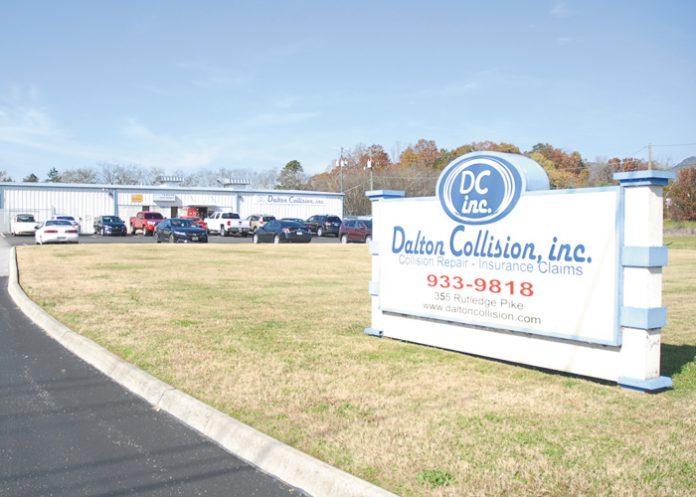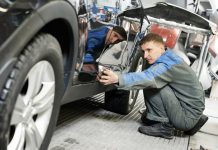By Gary Butler
If training is the key, then I-CAR certification is the “gold standard” in locks, according to Dalton Collision co-owner Jerry Dalton. Dalton takes great pride in operating what he says is the longest-running, currently-operational I-CAR Gold Class collision repair shop in the State of Tennessee, located at 355 Rutledge Pike in Blaine.
Dalton said his shop had been No. 3 in that category until edging up to the No. 1 spot after two other shops had fallen by the wayside.
“Training in new technology and equipment is no longer a luxury, but a necessity,” Dalton said. “Some of the technology used in making collision repairs is changing so quickly that it can make your head spin, so we rely heavily on I-CAR to keep us current.”
Dalton provides more than “lip service” when it comes to I-CAR training, as he is the chair of the Knoxville (Tenn.) I-CARCommittee, and he is a Pro-level 3 Estimator.
“I have to take six hours of continuous education every year just to maintain that certification, and I take training very seriously,” he said.
Dalton said he and his wife and co-owner, Donna, leave no stone unturned when it comes to their own training and that of their technicians.
“I-CAR training isn’t cheap, but when you compare it to sending people to [training] facilities all over the country, it’s a good value for the money,” he asserted.
Dalton also said that new technicians who join his team are usually already I-CAR-certified when they come on board, but if not he and his wife make sure they get certified as soon as possible. But he noted that the way in which technicians get certified has evolved some from years past.
“Many of the larger shops, the I-CAR Gold shops that is, have sponsored I-CAR training classes at their shops in the past, but that is beginning to change,” he said. “I-CAR is moving more and more toward conducting their training at technical schools and vocational departments of high schools.
“The I-CAR Development Program is being taught at several high schools and technical schools in this area, and when students complete that course they will have a certification in non-structural and/or refinish,” he said. “So now, when a student comes to work for us from one of those schools, he or she will already have their I-CAR certification. The I-CAR culture is definitely shifting toward getting technicians trained before they enter the work force.
“Obviously, that will save us some money, money that we can use to invest in new equipment and expansion plans we have for the future,” Dalton said.
Dalton noted that his shop has expanded from 8,600 square feet in 2001, when the Automotive Report first interviewed him, to its current 13,350 square feet, and that he plans to increase the size of the facility enough to add another downdraft paint booth to the one CMC booth he currently uses, and additional office space as well. He also noted other significant changes that have taken place in that 16-year span.
“We now have three Car-O-Liner frame racks, a Road Force tire balancing system, and three years ago we added a Hunter wheel alignment system. We’ve changed compression welders twice since you were here in 2001, and added a nitrogen welder. And our computerized measuring system has changed twice, and we added a $30,000 Car-O-Liner computerized welder in 2011.
“And then we added an aluminum repair room,” he said. “Aluminum repair has been a big part of the ‘learning curve’ I keep referring to concerning new technology.”
Dalton said that aluminum used primarily on Ford trucks (but other vehicles as well) has forced mid-sized-to-larger shops to invest not only in new equipment, but many hours of training in how to use that equipment. Small shops, he says, are largely unable to make such purchases, because their overhead just won’t support the expenditure.
“The trend is clearly moving toward lighter, stronger vehicles, that much is certain, and that has been true for some time,” he said. “But the use of aluminum complicates collision repair in some ways. For one thing, you have to keep aluminum and steel separate from each other. If a truck manufacturer puts an aluminum bed on a steel frame, they have to put a liner between them.
“But aluminum is more repairable than steel, in the sense that you can heat it, stop heating it, then start heating it again, as long as you don’t go over 425 degrees, depending upon where it’s manufactured,” he said. “You can’t do that with steel. You get one shot at it, and then it becomes weak. In some ways it’s a trade-off, because lighter materials like aluminum, or carbon fiber and other materials, give you increased fuel economy, but they are more expensive to work on, it takes new equipment and training, and more time for the repair.
“Each time a new model of a vehicle made with these lighter materials comes out, we have to take the time to learn how to work on them,” he said. “Even something as simple as a magnesium radiator support.”
For all his emphasis on training, though, Dalton said his shop’s guiding principle revolves around safety.
“A safe repair is the single most important thing we can offer our customers,” he said. “People used to refer to this road out here as ‘bloody 11-W,’ and there was a reason for that. Cars weren’t as safe back then as they are now, and our job is to make sure every car that rolls out of our shop is as safe as it was when it left the factory.”
But repairing vehicles safely is more complicated than it used to be, according to Dalton.
“I’ve heard both sides of crash test results comparing aluminum to steel, and it isn’t definitive yet,” he said. “Cars are unquestionably far, far safer these days than they were years ago, but repairing them is more complicated. It is so easy these days to ‘total’ a vehicle, because hidden damage can present itself once we are into the repair.”
Dalton said that because of potentially “hidden” damage his shop conducts both pre- and post-repair scans of vehicle damage, especially for manufacturers like Honda, Accura, Nissan, and Infinity, which all require these scans for hidden “DTC codes,” which stands for diagnostic trouble codes.
“The vehicle might not display a check engine light, air bag light, or ABS light, which are all malfunction indicator lights, but when you move a car around during the repair or replace parts on it, one of these hidden DTCs can show up,” he said.
In part because of such potentially hidden damage, Dalton said many manufacturers and insurance companies are trending toward requiring their direct repair facilities (DRP) to be certified repair providers (CRP) as well.
“And that requires you to have, among other things, I-CAR Gold Class status, or possibly Verifax,” he said.
For all those reasons and more, Dalton said he believes it would take “at least a $1 million buy-in to start a viable mid-sized shop these days.
“What with high overhead costs, expensive equipment, and training, I don’t see how you could do it for less than that, at a minimum,” he said. “And of course you have four major consolidators which are buying up many shops that are struggling. I could name one company that owns 27 shops around the country, and seven shops in Knoxville are owned by two consolidators.”
Dalton said his shop tries to not only see that his technicians are well trained, but give back to the community in a broader sense.
“In May we had our 25-year anniversary of being in business, and we participated in a golf tournament and helped raise $5,000 each for four area trade schools, and the Collision Education Foundation also donated $25,000 to Greeneville High School’s collision department,” he said.
Dalton said his customer base has grown not only because of his attention to detail, his insistence on the highest quality of repair work, and his shop’s “safety first” attitude, but also because of an increasing awareness of the customers’ need to “be a part of the process.
“We post photos on our website that give our customers the opportunity to see the work being done in various phases, and that means a lot to some of them,” he said.
One such customer, Dalton recalled, was a lady who had named her car “Jenny,” and who was particularly attached to the car, he said.
“During one phase of that repair, we made a big paper banner that spelled out ‘Jenny’ in big letters and had one of our employees take a picture of me and one of our office staff holding it in front of the car,” he recalled. “We posted that on the website, and it really pleased the customer and made her feel like we cared about her attachment to her car.”
Dalton said his two sons and his son-in-law all work at the shop in various capacities, and each sees himself one day branching out and having his own location.
“But for now, they each are committed to the team we have here, and they work extremely well with each other,” he said. “In fact, everyone here works well as a team. We learned a long time ago that we are interdependent and that every department needs the other departments to succeed.
“Body repair, paint shop, estimators, mechanical repairs, and office staff—they are all committed to learning new technology, new processes, and being ready to take it to the next level,” Dalton said. “It is truly a learning culture that we teach here.” •



